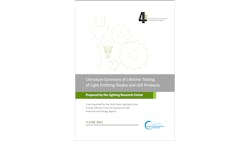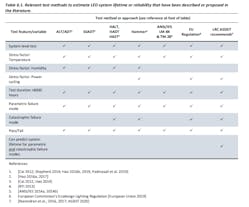The International Energy Agency (IEA) Energy Efficient End-use Equipment (4E) Solid-state Lighting (SSL) Annex has published new research on the state of testing methodologies used to characterize the lifetime of lighting products at the system level. The report titled “Literature Summary of Lifetime Testing of Light Emitting Diodes and LED Products” was prepared by the Lighting Research Center (LRC) at Rensselaer Polytechnic Institute (RPI) and is based on a comprehensive review of literature focused on testing LED sources and SSL systems to determine expected lifetime. The most widely-used testing standards today don’t consider both parametric and catastrophic failure, according to the document, and also fail to consider stress conditions such as humidity and power cycling.
Realistically, the LED and SSL sectors have come a long way in standardizing effective test methodologies and reporting requirements. Consider that a decade ago, there were no widely-followed methodologies and manufacturers published wild claims, especially related to expected product lifetime of lamps and luminaires. Meanwhile, many such products failed very prematurely. Over the course of the decade, standards developed primarily by the Illuminating Engineering Society (IES) have greatly improved the situation. Still, the IEA 4E SSL Annex suggests that further improvement is possible.
Today, IES LM-80 and TM-21 standards are widely used to define test and reporting methodologies and project lifetime, respectively, for LED sources and light engines. In turn, the LM-84 and TM-28 standards build on the light source work to enable characterization of luminaires along with lifetime projections. The new report acknowledges these standards but points out that the work is based on parametric failure where over time a product becomes unusable due to lumen depreciation or chromaticity shift. The report said catastrophic failure needs to be addressed especially when SSL system-level design can result in excess heat that causes LEDs and other electronics to fail.
As mentioned, the LRC performed the literature review behind the new report. And as we have reported, that RPI laboratory has undergone significant recent change. Much of the LRC team has moved with former LRC director Mariana Figueiro to a new laboratory at Mount Sinai called the Center for Light and Health Research. Still, core members of the original LRC team remain at the RPI lab including director of research Nadarajah Narendran, who has been the lead LRC researcher in the area of LED and SSL lifetime.
The new IEA 4E SSL Annex report cites LRC work as the most comprehensive methodology for testing SSL products and projecting lifetime, followed closely by a standard developed in the European Union. In 2020, the LRC published Volume 14 in its Alliance for Solid-State Illumination Systems and Technologies (ASSIST) initiative that’s funded by industry partners. The document titled “Recommendations for Testing LED Lighting Systems and Projecting System Lifetime in Different Applications” added power cycling to the requirements defined in the IES standards and therefore one cause of catastrophic failure.
Still, the new report urges the industry to go further and also add testing of systems at high levels of humidity to deliver the best projections of reliability. We at LEDs Magazine would argue that such testing might be overkill for most indoor general illumination applications. It could, however, be very valuable in outdoor and specialty-indoor applications. One other recommendation is a deeper look at driver lifetime projection methodology, and indeed, the driver can be the weakest link in an SSL system.
The IEA 4E SSL Annex is a market transformation initiative supported by a number of global powers, not including the US, but that was intended to enable countries without agencies such as the US Department of Energy to encourage the adoption of LED lighting and do so with high-quality products. For example, the organization published recommendations on product performance in applications from replacement lamps to street lights. The international roster of supporters includes the governments of Australia, Canada, Denmark, France, the Republic of Korea, Sweden, and the United Kingdom.
“Lifetime testing is a critical aspect of overall product testing for LED products,” said Professor Georges Zissis, chair of the SSL Annex’s management committee and representative from France. “This report was prepared for us by the experts at the Lighting Research Center in New York, USA, and it offers a high-level summary of all the recent lifetime literature and failure mechanisms, giving guidance on which approach is deemed most effective today.”
LEDs Magazine chief editor MAURY WRIGHT is an electronics engineer turned technology journalist, who has focused specifically on the LED & Lighting industry for the past decade.
*Updated June 17, 2021 9:34 AM for illustrations and report link update.
For up-to-the-minute LED and SSL updates, why not follow us on Twitter? You’ll find curated content and commentary, as well as information on industry events, webcasts, and surveys on our LinkedIn Company Page and our Facebook page.







